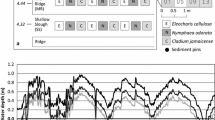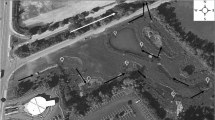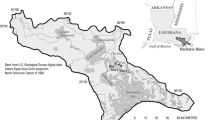Abstract
Planted vegetation survival and growth, hydrology, and phosphorus dynamics were monitored for the first two years of wetland development at a 6-ha created riparian wetland, in Franklin County, Ohio, USA. Herbaceous vegetation developed clear zonation and appeared to reduce the invasion ofTypha spp. Of the 17 species introduced, 8 were among the 18 most commonly encountered species approximately 2 years after the wetland was constructed. Planted saplings generally survived except where they were found in standing water;Liquidambar styraciflua andBetula nigra were less successful because the site is close to their northern range. Simulation models were developed to predict hydrology, phosphorus retention, and tree growth. The site has a rapidly pulsing hydroperiod driven by runoff from storm events. Annual simulated phosphorus loading was 17.8 gP m−2 yr−1 and retention was 2.9 gP m−2 yr−1 (16% of inflow). Fifty years of tree growth simulated for each planted tree species indicated that the site will develop into a forested wetland dominated byQuercus palustris andFraxinus pennsylvanica with basal area comparable to riparian forests but with lower stem density unless seedlings germinate from the planted trees. Lower water levels in the wetland would favor the development of the woody vegetation over herbaceous vegetation and would also favor higher retention of phosphorus.
Similar content being viewed by others
Literature Cited
American Public Health Association. 1989. Standard Methods for the Examination of Water and Wastewater. American Public Health Association, American Water Works Association, and the Water Pollution Control Federation, Washington, DC, USA.
Atkinson, R. B., J. E. Perry, E. Smith, and J. Cairns, Jr. 1993. Use of created wetlands delineation and weighted averages as a component of assessment. Wetlands 13:185–193.
Bellport, B. P., and G. E. Burnett (eds.) 1984. Water Measurement Manual, U.S. Department of the Interior, Bureau of Reclamation. Denver, CO, USA.
Botkin, D. B. 1993. Forest Dynamics: An Ecological Model. Oxford University Press. New York, NY, USA.
Brix, H. 1994. Constructed wetlands for municipal wastewater treatment in Europe. p. 325–333.In W. J. Mitsch (ed.) Global Wetlands: Old World and New. Elsevier, Amsterdam, The Netherlands.
Chow, V. T. (ed.). 1964. Handbook of Applied Hydrology. McGraw-Hill, New York, NY, USA.
Craft, C. B. and C. J. Richardson. 1993 Peat accretion and N, P, and organic C accumulation in nutrient-enriched and unenriched Everglades peatlands. Ecological Applications 3:446–458.
Erwin, K. A. 1991. An evaluation of wetland mitigation in the South Florida Water Management District, Vol. 1, Final Report to South Florida Water Management District, West Palm Beach, FL, USA.
Ewel, K. C. and H. T. Odum (eds.). 1984. Cypress Swamps. University Presses of Florida, Gainesville, FL, USA.
Fennessy, M. S. and W. J. Mitsch. 1989. Treating coal mine drainage with an artificial wetland. Research Journal of the Water Pollution Control Federation 61:1691–1701.
Hammer, D. A. (ed.). 1989. Constructed Wetlands for Wastewater Treatment: Municipal, Industrial and Agricultural. Lewis Publishers, Inc., Chelsea, MI, USA.
Hey, D. L., M. A. Cardamone, J. H. Sather, and W. J. Mitsch. 1989. Restoration of riverine wetlands: the Des Plaines River Wetlands Demonstration Project. p. 159–184. In: W. J. Mitsch and S. E. Jørgensen (eds.) Ecological Engineering: An Introduction to Ecotechnology. Wiley, New York, NY, USA.
Jarman, N. M., R. A. Doberteen, B. Windmiller, and P. R. Lelito. 1991. Evaluation of created freshwater wetlands in Massachusetts. Restoration and Management Notes 9:26–29.
Jørgensen, S. E. 1986. Fundamentals of Ecological Modelling. Elsevier, Amsterdam, The Netherlands.
Kadlec, R. H. 1994. Wetlands for water polishing: free water surface wetlands. p. 335–349.In W. J. Mitsch (ed.) Global Wetlands: Old World and New. Elsevier, Amsterdam, The Netherlands.
Kadlec, R. H. and J. A. Kadlec. 1979. Wetlands and water quality. p. 436–456.In: P. E. Greeson, J. R. Clark, and J. E. Clark (eds.) Wetland Functions and Values: The State of Our Understanding. American Water Resources Association, Minneapolis, MN, USA.
Kentula, M. E., R. P. Brooks, S. E. Gwin, C. C. Holland, A. D. Sherman, and J. C. Sifneos. 1992. Wetlands: An Approach to Improving Decision Making in Wetland Restoration and Creation. Island Press, Washington, DC, USA.
Knight, R. L. 1990. Wetland Systems p. 211–260.In Natural Systems for Wastewater Treatment, Manual of Practice FD-16. Water Pollution Control Federation, Alexandria, VA, USA.
Kusler, J. and M. E. Kentula. 1990. Wetland Creation and Restoration: The Status of the Science. Island Press, Washington, DC, USA.
Kusler, J., W. J. Mitsch, and J. S. Larson. 1994. Wetlands. Scientific American 270:64–70.
Mitsch, W. J. 1992. Landscape design and the role of created, restored, and natural riparian wetlands in controlling nonpoint source pollution. Ecological Engineering 1:27–47.
Mitsch, W. J., and B. C. Reeder. 1991. Modelling nutrient retention of a freshwater coastal wetland: estimating the roles of primary productivity, sedimentation, resuspension, and hydrology. Ecological Modelling 54:151–187.
Mitsch, W. J. and J. K. Cronk. 1992. Creation and restoration of wetlands: some design consideration for ecological engineering. p. 217–259.In: R. Lal and B. A. Stewart (eds.) Advances In Soil Science, Vol. 17. Springer-Verlag New York, Inc., New York, NY, USA.
Mitsch, W. J. and J. G. Gosselink. 1993. Wetlands 2nd ed. Van Nostrand Reinhold, New York, NY, USA.
Mitsch, W. J. and X. Wu. 1995. Olentangy River Wetland Research Park at The Ohio State University: Annual Report 1994. The Ohio State University, Columbus, OH, USA.
Mitsch, W. J. J. K. Cronk, W. Wu, R. W. Nairn, and D. L. Hey. 1995. Phosphorus retention in constructed freshwater riparian marshes. Ecological Applications. in press.
Mitsch, W. J. and R. F. Wilson. in press. Improving the success of wetland creation and restoration with know-how, time, and self-design. Ecological Applications.
Odum, H.T.. 1983. Systems Ecology: An Introduction. Wiley, New York, NY, USA.
Odum, H. T., K. C. Ewel, W. J. Mitsch, and J. W. Ordway. 1977. Recycling treated sewage through cypress wetlands in Florida. p. 35–67.In F. M. D’Itri (ed.) Wastewater Renovation and Reuse. Marcel Dekker, New York, NY, USA.
Pearlstine, L., H. McKellar, and W. Kitchens. 1985. Modelling the impacts of a river diversion on bottomland forest communities in the Santee River floodplain South Carolina. Ecological Modelling 29:281–302.
Petrides, G. A. 1988. Eastern Trees. Houghton Mifflin Co., Boston, MA, USA.
Phipps, R. L. 1979. Simulation of wetlands forest vegetation dynamics. Ecological Modelling 29:257–288.
Reed, P. B., Jr. 1988. National List of Plant Species that Occur in Wetlands: Northeast (Region 1). U.S. Fish and Wildlife Service, Washington, DC, USA, Biological Report 88 (26.1).
Reinartz, J. A. and E. L. Warne. 1993. Development of vegetation in small created wetlands in southeast Wisconsin. Wetlands 13: 153–164.
Richmond, B., S. Peterson, and P. Vescuso. 1987. An Academic User’s Guide to STELLA. High Performance Systems, Lyme, NH, USA.
Ruffner, J. A. and F. E. Bair (eds.). 1987. The Weather Almanac, Gale Research Company Book Tower, Detroit, MI, USA.
Sanville, W. and W. J. Mitsch (eds.). 1994. Creating Freshwater Marshes in a Riparian Landscape: Research at the Des Plaines River Wetland Demonstration Project. Ecological Engineering 3:315–521.
Sargent, C. S. 1933. Manual of the Trees of North America. The Riverside Press, Cambridge, MA, USA.
Sifneos, J. C., E. W. Cake, Jr. and M. E. Kentula. 1992. Effects of Section 404 permitting on freshwater wetlands in Louisiana, Alabama, and Mississippi. Wetlands 12:28–36.
U.S. Soil Conservation Service. 1987. Hydric Soils of the United States. In cooperation with the National Technical Committee for Hydric Soils, Washington, DC, USA.
Weider, R. K. 1989. A survey of constructed wetlands for acid coal mine drainage treatment in Eastern United States. Wetlands 9:299–315.
Wentworth, T. R., G. P. Johnson, and R. L. Kologiski. 1988. Designation of wetlands by weighted averages of vegetation data: A preliminary evaluation. Water Resources Bulletin 24:389–396.
Author information
Authors and Affiliations
Rights and permissions
About this article
Cite this article
Niswander, S.F., Mitsch, W.J. Functional analysis of a two-year-old created in-stream wetland: Hydrology, phosphorus retention, and vegetation survival and growth. Wetlands 15, 212–225 (1995). https://doi.org/10.1007/BF03160701
Received:
Revised:
Accepted:
Issue Date:
DOI: https://doi.org/10.1007/BF03160701




